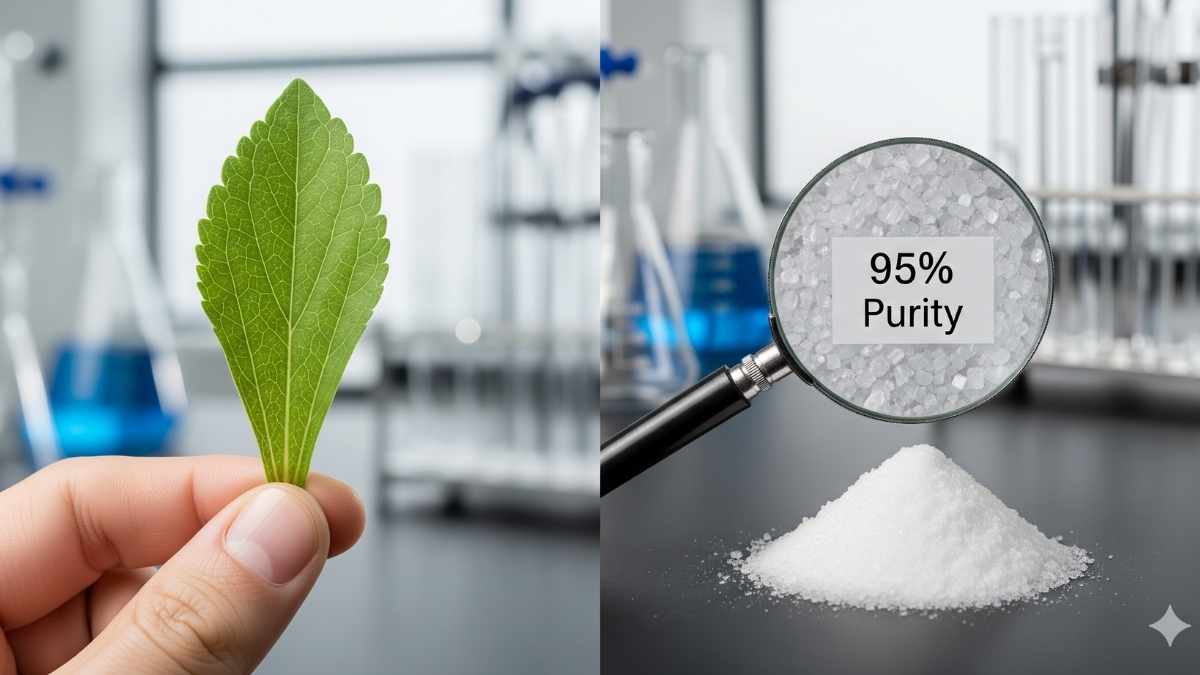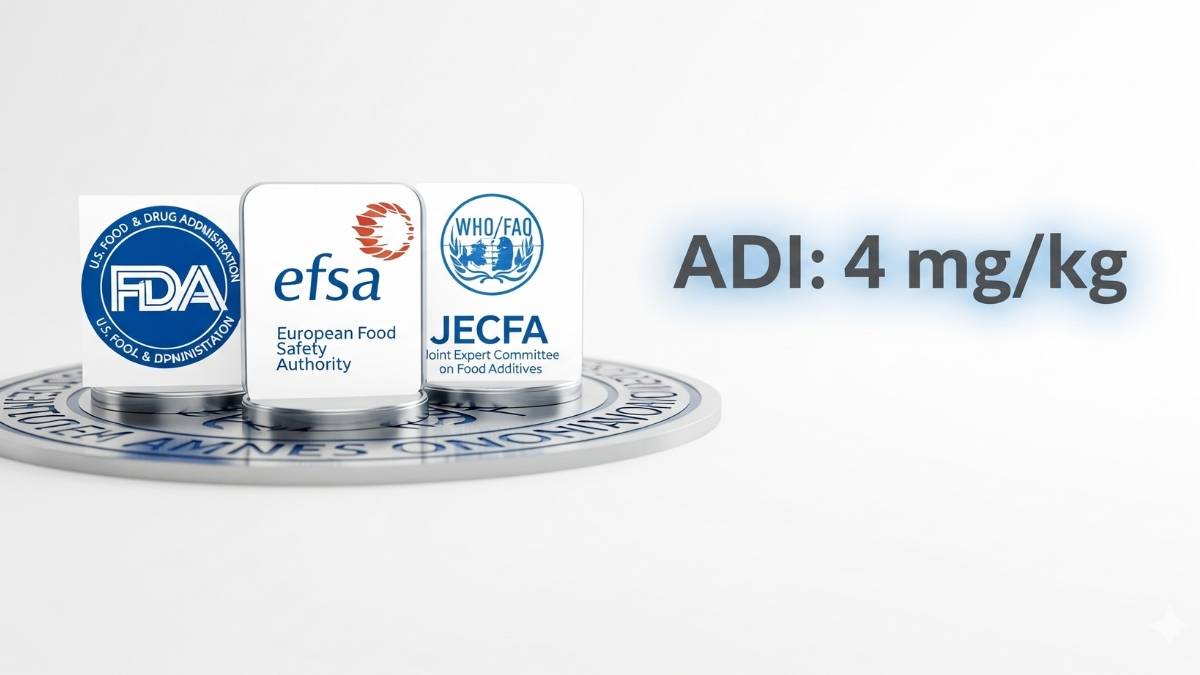Is Stevia Bad For You? The Definitive Fact-Check on
Cancer, Chronic Effects, and Purity 🌿
If you’re anything like me—a health-conscious person trying to manage your family’s sugar intake—you’ve likely stood in the grocery aisle, looking at a packet of Stevia, and felt a knot of anxiety. The headlines are confusing: one day, Stevia is a natural savior; the next, a viral post claims it causes cancer or long-term organ damage. As a PhD Student who grew up farming and now relies on rigorous science, I know that feeling of needing a straight answer, backed by solid evidence.
The core question for millions of people is: Is stevia bad for you, really?
I want to be very clear in this process. I will talk straight. I want to dismantle the most prominent health myths about Stevia.

A Quick Summary: The Final Word on Stevia Safety Myths 🎯
You are looking for some proof, and that's exactly what the top global regulatory bodies provide. Here is a summary of the facts that counter the highest-anxiety claims:
- Purity is Everything: The safety conclusion applies only to high-purity steviol glycosides (at least 95% purity). Crude stevia leaf and extracts are actively restricted by the FDA due to safety uncertainty.
- The Cancer Myth is Busted: Claims of carcinogenicity or DNA damage (mutagenicity) are based on old, flawed studies that used chemically impossible mega-doses—the equivalent of consuming thousands of cups of coffee per day.
- No Long-Term Organ Damage: Toxicological studies show purified stevia is safe for chronic use. The same conservative doses that reported liver or reproductive concerns were based on high-dose crude extracts, not the purified product we buy today.
- Global Regulatory Consensus: The U.S. FDA, the European Food Safety Authority (EFSA), and the WHO’s JECFA all agree on the exact same Acceptable Daily Intake (ADI) of 4 mg/kg of body weight per day.
The Core Truth: The Scientific Answer to Is Stevia Bad
For You? (95% Minimum Purity)
When we talk about Stevia, we often picture the sweet little plant growing in the ground. But from an academic perspective, the difference between that raw leaf and the white powder in your coffee is the single most important factor in understanding its safety profile.
The Purity Rule: Separating the Safe Sweetener from the
Crude Leaf
I’ve grown stevia in my home garden—it’s a beautiful, sweet plant. But as a farmer, I know that raw plants contain hundreds of compounds, and not all of them are safe for consumption in concentrated amounts.
The sweetener deemed safe by the FDA and EFSA is not the raw, whole leaf. It is a highly refined food additive called steviol glycosides, such as Rebaudioside A (Reb-A). This extract must meet a minimum purity standard of 95% steviol glycosides.
Why this strict rule?
The safety and GRAS (Generally Recognized As Safe) status apply only to this purified extract. The safety of the crude stevia leaf and crude extracts, conversely, has not been fully characterized. In fact, the FDA maintains an active import alert against these crude forms due to unresolved concerns about potential toxicity and impurities.
The science is clear here: the refined product has been rigorously tested and confirmed safe; the crude leaf has not. If you are consuming a commercial sweetener, always check the label to ensure it specifies "high-purity steviol glycosides" or a similar term.
The Metabolism Check: How Your Body Handles Stevia
Another key to understanding stevia safety is knowing that it's fundamentally different from sugar because your body cannot access its calories.
The large steviol glycoside molecules travel through your stomach and small intestine mostly intact. They are simply too big for the digestive enzymes in your upper gut to break down. They pass down to the colon, where the gut microbiota—your friendly gut bacteria—step in. These microbes break the glycosides down into a substance called steviol. This steviol is then absorbed, processed by the liver, and rapidly eliminated through the urine.
Because the molecule is primarily metabolized after the point where calories are absorbed, it is effectively zero-calorie. This metabolic pathway is well-understood and has been crucial in confirming its safety status for diabetics and weight managers.
Fact-Check 1: Does Stevia Cause Cancer? (The
Carcinogenicity Rebuttal)
The most alarming myth circulating about any sweetener is the cancer risk. It’s what keeps concerned parents and health advocates—like you—up at night. As a trusted friend, I want to reassure you: the overwhelming scientific consensus is that purified steviol glycosides are non-carcinogenic.

Refuting the Mutagenicity Myth: The Dose is the Poison
The persistent rumor of a cancer link stems from confusing, early studies performed decades ago. Researchers were testing the compound to see if it was "mutagenic"—meaning it could damage DNA and potentially lead to cancer.
Here is the context we need: one study did find weak mutagenic activity. However, this effect only occurred at a massive dosage. When scientists calculated what that dosage would look like for a human, they found it was equivalent to drinking the Stevia found in approximately 3,000 cups of coffee per day!
That's a quantity no human could possibly consume. It's an example of how the dose makes the poison. Water, salt, and even air can be toxic in non-physiologically relevant, extreme doses. The fact that the negative effect appears only at such an impossible mega-dose proves the compound is safe under normal, everyday consumption.
The Scientific Verdict on Stevia Safety and Cancer
When we look at comprehensive reviews of human data, the picture is clear.
- A large meta-analysis comparing cancer risk between consumers and non-consumers of artificial sweeteners found that "any" consumption was not associated with an increased risk of cancer overall. This finding holds true across different age groups and genders.
- An umbrella review, synthesizing multiple analyses, confirmed that there is no significant association between artificial sweetener intake and overall cancer risk. In fact, some analyses even suggested a higher intake might be linked to a reduced risk of gynecological cancers.
In my research, I see that the American Cancer Society considers the common amount of Stevia and other non-nutritive sweeteners used in diets to be safe.
Stevia vs. Other Sweeteners: A Genotoxicity Comparison
If you're looking for a "cleaner" label, Stevia stands out in its category.
Recent research has raised concerns about some artificial sweeteners, such as sucralose-6-acetate, a chemical found in the common sweetener sucralose. This compound was suggested to be genotoxic and potentially harmful to gut health.
By contrast, rigorous in vivo (in living organisms) testing of Stevia extract using the Comet assay on mouse organs showed no DNA-damaging activity after oral administration, even at high doses. This evidence powerfully confirms that purified steviol glycosides are a low-risk option in terms of genetic integrity, making them an appealing choice for families seeking better alternatives.
Fact-Check 2: Long-Term Stevia Side Effects and Chronic
Use
The next logical concern for the proactive protector—the parent or health manager—is what happens after years of use. Will this sweetener cause "stevia side effects" that damage internal organs or affect fertility?
Organ Health: Rebutting Liver and Kidney Stress Claims
The fear that Stevia might stress the liver or kidneys comes from two directions:
1. The Diuretic Effect: Stevia is a known diuretic, meaning it increases the speed at which the body expels water and electrolytes faster. Some researchers initially worried that this effect could strain the kidneys long-term.
2. Flawed Animal Studies: Some early, high-dose animal studies reported elevated liver enzymes and severe damage to liver and kidney sections.
But the science has evolved, and the verdict is highly reassuring.
As a PhD student, I focus on the clinical trials that are relevant to human use. Recent studies suggest that Stevia may be nephroprotective—meaning it may protect the kidneys. A 2018 clinical trial involving people with chronic kidney disease found that stevia supplements actually reduced markers of kidney damage, including creatinine and uric acid.
This evidence suggests that Stevia’s overall biological effects—which include anti-inflammatory and blood-pressure-reducing properties—may be beneficial to these organs, overcoming any purely theoretical toxicity from extreme, unapproved doses.
Organ Health: Rebutting Liver and Kidney Stress Claims
The fear that Stevia might stress the liver or kidneys comes from two directions:
1. The Diuretic Effect: Stevia is a known diuretic, meaning it increases the speed at which the body expels water and electrolytes faster. Some researchers initially worried that this effect could strain the kidneys long-term.
2. Flawed Animal Studies: Some early, high-dose animal studies reported elevated liver enzymes and severe damage to liver and kidney sections.
But the science has evolved, and the verdict is highly reassuring.
As a PhD student, I focus on the clinical trials that are relevant to human use. Recent studies suggest that Stevia may be nephroprotective—meaning it may protect the kidneys. A 2018 clinical trial involving people with chronic kidney disease found that stevia supplements actually reduced markers of kidney damage, including creatinine and uric acid.
This evidence suggests that Stevia’s overall biological effects—which include anti-inflammatory and blood-pressure-reducing properties—may be beneficial to these organs, overcoming any purely theoretical toxicity from extreme, unapproved doses.
Reproductive Safety and Fertility
Growing up on a farm, I learned the importance of reproductive health in every living thing. Early concerns about Stevia and fertility arose from inconsistent animal studies that used very high doses of crude Stevia extracts.
The key distinction is, again, the purity. The comprehensive toxicology reviews undertaken by the FDA, EFSA, and JECFA have shown no evidence of reproductive toxicity or birth defects (teratogenic effects) associated with the purified sweeteners. Therefore, if you are using an approved, high-purity product, these historical concerns are considered unfounded and safely addressed by the regulatory framework.
Gut Microbiome: The Emerging Research Frontier
Since your gut bacteria are the ones doing the heavy lifting to metabolize Stevia, its long-term effect on your gut health is a valid question.
My research shows that this is an active area of study, but the early human data is promising. While preclinical studies suggest Stevia may alter bacterial communication, a 12-week human clinical trial investigating chronic Stevia consumption found that it did not significantly alter the overall composition of the human gut microbiota.
In short, there’s no current evidence of significant long-term harm to your gut biome, but researchers are continuing to monitor this for any subtle functional changes over the years of use.
Fact-Check 3: The Regulatory Foundation (The ADI
Consensus)
If you are a skeptical consumer—and I encourage that you should be!—you need hard evidence from objective global authorities. The most powerful proof of chronic stevia safety is the consistent, unanimous consensus among the world’s leading regulatory bodies.
The 1991 Ban: Explaining Why Was Stevia Banned (and
Reversed)
Many readers feel concerned when they hear the historical fact that Stevia was banned in the U.S. in 1991. The question "why was stevia banned" is a crucial one that needs a clear, contextual answer.
The FDA initially banned Stevia in 1991 due to early, inconclusive studies suggesting a potential cancer link. This was a precautionary measure based on preliminary data.
However, as robust toxicological data accumulated, the FDA's position shifted:
- 1995: The ban was revised to allow Stevia leaves and crude extracts to be imported as dietary supplements, but still not as food sweeteners.
- 2008: The FDA designated high-purity stevia extracts (95% minimum purity) as GRAS.
This timeline is a story of scientific rigor in action. The ban wasn't permanent; it was a temporary caution that was reversed once the evidence confirmed the purified product’s safety.
JECFA, FDA, and EFSA: The Unanimous ADI

The ultimate proof of safety lies in the Acceptable Daily Intake (ADI). The ADI is established by the world's top scientific bodies and represents the amount of a substance that can be consumed safely every day over an entire lifetime without risk.
The Joint FAO/WHO Expert Committee on Food Additives (JECFA), the European Food Safety Authority (EFSA), and the U.S. FDA all agree on the exact same limit :
Acceptable Daily Intake (ADI): 4 milligrams per kilogram of body weight per day (expressed as steviol equivalents).
How do they reach this number? They identify the No Observed Adverse Effect Level (NOAEL) from long-term animal studies, and then they apply a massive 100-fold safety factor. This means the ADI is 100 times lower than the maximum dose where no adverse effects were observed. This 100-fold margin of safety provides the highest possible level of consumer protection.
Practical Guidance: What Your ADI Means
For a standard adult, the ADI translates to a very substantial amount of sweetener, confirming that normal use is incredibly safe.
Calculating Your Safe Lifetime Limit (ADI) 💡
| Your Body Weight (Approx.) ⚖️ | Maximum Safe Daily Intake (Steviol Equivalent) 🎯 | Consumption Guidance 🛡️ |
|---|---|---|
| 110 lbs (50 kg) | 200 mg | You would need to consume 40 to 50 packets of common stevia sweetener every day, consistently, to reach this limit. ☕ |
| 150 lbs (68 kg) | 272 mg | This is the standard, conservative ceiling for a lifetime of chronic use, and it is rarely approached in a typical diet. ✅ |
| 200 lbs (90 kg) | 360 mg | Exceeding this limit requires massive, intentional intake of highly concentrated products, far beyond what is used to sweeten beverages. ⚠️ |
Final Synthesis: Confidence in Chronic Safety 💪
As your trusted friend and someone who engages with this science daily, I can give you a definitive verdict: the decades of research and rigorous toxicological evaluation confirm that high-purity steviol glycosides are a safe and reliable sugar alternative for chronic use.
If you are a diabetic managing blood sugar, a weight watcher, or a parent seeking a cleaner label, you can use high-purity Stevia with confidence. The scientific and regulatory consensus is strong, unified, and anchored by a 100-fold margin of safety. You deserve to feel reassured, and the evidence is entirely on your side.
Further Authoritative Reading
To delve deeper into the specific safety reviews conducted by international bodies:
1. Read more on the FDA's GRAS Status for Steviol Glycosides
2. Read more on the JECFA's Assessment of Steviol Glycosides and the ADI
3. Read more on the European Food Safety Authority (EFSA) Scientific Opinion on Steviol Glycosides
